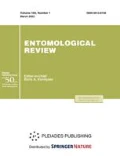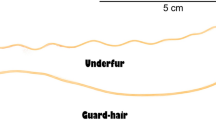Abstract
The structure of 76 skeletal elements of adult fleas was analyzed, and the distribution of 114 characters with 446 character states over the body tagmata, segments, and morphofunctional complexes was investigated. Among them, 40% of the characters (40) and their states (163) describe the diversity of the structures of the frontal complex (including those of the head and prothorax), which is related to the specific features of flea parasitism. A large part of the characters (18) and their states (83) describe the structures of the nototrochanteral complex of the meso- and metathorax responsible for jumping. The total number of all types of homoplasies (258 states) is almost 1.8 times as great as the number of the states (145) that may be regarded as synapomorphies. The ancestral states (43) comprise a smaller portion of the total number. The proportion of the synapomorphic and homoplastic character states varies between the morphofunctional complexes.
Similar content being viewed by others
References
Medvedev, S.G., “Morphological Basis of Classification of Fleas (Siphonaptera),” Entomologicheskoe Obozrenie 73 (1), 22–43 (1994).
Medvedev, S.G., “Classification of Fleas (Order Siphonaptera) and Its Theoretical Foundations,” Entomologicheskoe Obozrenie 77 (4), 916–934 (1998) [Entomological Review 78 (9), 1080-1093 (1998)].
Medvedev, S.G., “Specific Features of the Distribution and Host Associations of Fleas (Siphonaptera). I,” Entomologicheskoe Obozrenie 81 (3), 737–753 (2002) [Entomological Review 82 (9), 1165-1177 (2002)].
Medvedev, S.G., “Morphological Adaptations of Fleas (Siphonaptera) to Parasitism: I,” Entomologicheskoe Obozrenie 82 (1), 40–62 (2003) [Entomological Review 83 (9), 1059-1080 (2003)].
Medvedev, S.G., “On Systemic Analysis of the Evolution of the Order of Fleas (Siphonaptera),” in N.A. Kholodkovsky Memorial Lectures, Issue 57 (2) (2005), pp. 1–170 [in Russian].
Medvedev, S.G., “Classification of Flea Families (Siphonaptera): I. Family Hystrichopsyllidae (First Part),” Entomologicheskoe Obozrenie 85 (2), 441–463 (2006a) [Entomological Review 86 (4), 460-477 (2006)].
Medvedev, S.G., “Classification of Flea Families (Siphonaptera): I. Family Hystrichopsyllidae (Part 2),” Entomologicheskoe Obozrenie 85 (4), 901–917 (2006b) [Entomological Review 86 (9), 1084-1096 (2006)].
Medvedev, S.G., “Classification of Flea Families (Siphonaptera): I. Family Hystrichopsyllidae (Part 3),” Entomologicheskoe Obozrenie 86 (2), 439–454 (2007) [Entomological Review 87 (4), 431-442 (2007)].
Medvedev, S.G., “Classification of Flea Families (Siphonaptera): I. Family Hystrichopsyllidae (Part 4),” Entomologicheskoe Obozrenie 87 (3), 668–691 (2008) [Entomological Review 88 (7), 838-857 (2008)].
Medvedev, S.G., “Morphological Diversity of the Skeletal Structures of Fleas (Siphonaptera). Part 1: the General Characteristic and Features of the Head,” Entomologicheskoe Obozrenie 95 (3), 559–588 (2015a) [Entomological Review 95 (7), 852-873 (2015)].
Medvedev, S.G., “Morphological Diversity of the Skeletal Structures of Fleas (Siphonaptera). Part 3: The General Characteristics and Features of Thoracic Setation,” Parazitologiya 49 (6), 453–464 (2015b) [Entomological Review 96 (1), 51-58 (2016)].
Medvedev, S.G., “Morphological Diversity of the Skeletal Structures of Fleas (Siphonaptera). Part 2: The General Characteristic and Features of the Thorax,” Entomologicheskoe Obozrenie 96 (1), 34–63 (2016a) [Entomological Review 96 (1), 28-50 (2016)].
Medvedev, S.G., “Morphological Diversity of the Skeletal Structuresof Fleas (Siphonaptera). Part4:The General Characteristic and Features of the Abdomen,” Entomologicheskoe Obozrenie 96 (4), 801–822 (2016b) [Entomological Review 96 (8), 1069-1083 (2016)].
Medvedev, S.G., “Adaptations of Fleas (Siphonaptera) to Parasitism,” Parazitologiya 51 (4), 1–12 (2017) [Entomological Review 97 (8), 1023-1030 (2017)].
Rothschild, M. and Schlein, Y., “The Jumping Mechanism of Xenopsylla cheopis. 1. Exoskeletal Structures and Musculature,” Philosophical Transactions of the Royal Society Ser. B 271 (914), 457–490 (1975).
Whiting, M.F., Whiting, A.S., Hastriter, M.W., and Dittmar, K., “A Molecular Phylogeny of Fleas (Insecta: Siphonaptera) and Host Associations,” Cladistics 24, 1–31 (2008).
Zhu, Q., Hastriter, M.W., Whiting, M.F., and Dittmar, K., “Fleas (Siphonaptera) are Cretaceous and Evolved with Theria,” Molecular Phylogenetics and Evolution 90, 129–139 (2015).
Author information
Authors and Affiliations
Corresponding author
Additional information
Original Russian Text © S. G. Medvedev, 2018, published in Entomologicheskoe Obozrenie, 2018, Vol. 97, No. 1, pp. 16–31.
Rights and permissions
About this article
Cite this article
Medvedev, S.G. Morphological Diversity of the Skeletal Structures and Problems of Classification of Fleas (Siphonaptera). Part 6. Entmol. Rev. 98, 10–20 (2018). https://doi.org/10.1134/S0013873818010037
Received:
Published:
Issue Date:
DOI: https://doi.org/10.1134/S0013873818010037




